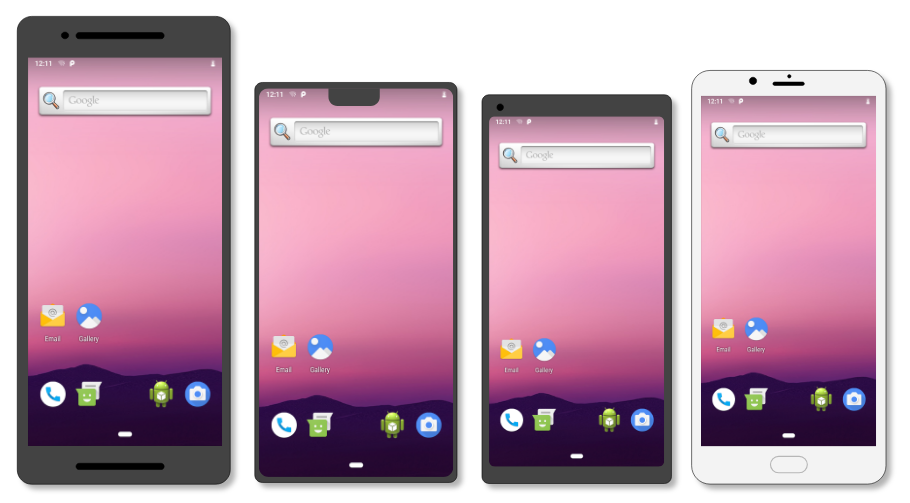Hình ảnh hệ thống chung (GSI) là hoạt động triển khai Android thuần tuý với Dự án nguồn mở Android chưa sửa đổi (AOSP), có thể chạy được trên nhiều thiết bị Android.
Nhà phát triển ứng dụng có thể cài đặt và chạy GSI mới nhất của Android để kiểm thử ứng dụng trên nhiều thiết bị Android hiện có và sử dụng GSI ở nhiều giai đoạn phát hành hệ điều hành Android, bao gồm cả Bản dùng thử cho nhà phát triển và bản dựng Beta. Việc thêm GSI vào quy trình xác minh và kiểm thử có thể mang lại thêm cho bạn một số lợi ích:
- Phạm vi kiểm thử rộng hơn trên nhiều thiết bị thực hơn
- Thêm thời gian để khắc phục các vấn đề về khả năng tương thích của ứng dụng
- Thêm cơ hội để khắc phục các vấn đề về khả năng tương thích trong Android theo báo cáo của nhà phát triển ứng dụng
Dự án GSI là nguồn mở và giúp cải thiện hệ sinh thái Android bằng cách mang lại thêm nhiều phương thức khác để cải thiện chất lượng của ứng dụng và hệ điều hành trước mỗi bản phát hành Android.

GSI bao gồm các chức năng hệ thống cốt lõi giống nhau trên mọi thiết bị cài đặt GSI. Nói cách khác, GSI không bao gồm các mục tuỳ chỉnh của nhà sản xuất thiết bị. Do đó, bạn có thể gặp sự khác biệt về hành vi trong những tình huống sau:
- Các hoạt động tương tác liên quan đến giao diện người dùng
- Quy trình công việc yêu cầu các tính năng phần cứng mới hơn
Kiểm tra tính tuân thủ của thiết bị
GSI chỉ có thể hoạt động trên những thiết bị có các đặc điểm sau đây:
- Trình tải khởi động đã mở khoá.
- Hoàn toàn tuân thủ với Treble.
- Khởi chạy bằng Android 9 (API cấp 28) trở lên. Các thiết bị được nâng cấp lên Android 9 từ phiên bản cũ có thể hỗ trợ hoặc không hỗ trợ GSI.
Để xác định xem thiết bị của bạn có thể dùng GSI hay không và bạn nên cài đặt phiên bản hệ điều hành GSI nào, hãy làm như sau:
Kiểm tra tính năng hỗ trợ Treble bằng cách chạy lệnh sau:
adb shell getprop ro.treble.enabled
Nếu phản hồi là
false, tức là thiết bị của bạn không tương thích với GSI và bạn không nên tiếp tục. Nếu phản hồi làtrue, hãy chuyển sang bước tiếp theo.Bạn có thể kiểm khả năng hỗ trợ giữa các phiên bản bằng cách chạy lệnh sau:
adb shell cat /system/etc/ld.config.version_identifier.txt \ | grep -A 20 "\[vendor\]"
Trong dữ liệu đầu ra, hãy tìm
namespace.default.isolatedtrong phần[vendor].Nếu giá trị của thuộc tính đó là
true, thì thiết bị sẽ hỗ trợ đầy đủ Bộ công cụ phát triển gốc dành cho nhà cung cấp (VNDK) và có thể sử dụng bất kỳ phiên bản hệ điều hành (OS) GSI nào mới hơn phiên bản hệ điều hành trên thiết bị. Bất cứ khi nào có thể, hãy dùng phiên bản hệ điều hành GSI mới nhất hiện có.Nếu giá trị của thuộc tính này là
false, tức là thiết bị chưa hoàn toàn tuân thủ VNDK và thiết bị này chỉ có thể sử dụng GSI dành cho phiên bản hệ điều hành của thiết bị. Ví dụ: thiết bị Android 10 (API phiên bản 29) không tuân thủ VNDK chỉ có thể tải hình ảnh GSI của Android 10.Loại kiến trúc CPU của GSI phải khớp với kiến trúc CPU của thiết bị. Để tìm kiến trúc CPU phù hợp cho hình ảnh GSI, hãy chạy lệnh sau:
adb shell getprop ro.product.cpu.abi
Sử dụng dữ liệu đầu ra để xác định cần sử dụng hình ảnh GSI nào khi cài đặt ROM thiết bị của bạn. Ví dụ: trên Pixel 5, dữ liệu đầu ra sẽ cho biết rằng kiến trúc CPU là
arm64-v8a, vì vậy, bạn sẽ sử dụng loạiarm64của GSI.
Tải GSI xuống
Có một số cách để tải GSI, tuỳ thuộc vào nhu cầu phát triển của bạn:
- Đối với GSI bản xem trước và GSI của Android có GMS, hãy tải hình ảnh xuống từ trang phát hành GSI.
Đối với hình ảnh GSI dựng sẵn không có ứng dụng GMS, hãy tải hình ảnh xuống từ trang web AOSP CI:
Để xây dựng GSI của Android không có GMS, hãy tải mã nguồn xuống từ AOSP và tạo GSI của bạn.
Cài đặt GSI
Việc cài đặt GSI phụ thuộc vào thiết bị. Hãy tham khảo nhà sản xuất thiết bị của bạn để biết các công cụ và quy trình chính xác. Đối với các thiết bị Google Pixel như Pixel 3 trở lên, có một số cách cài đặt như sau:
- Cài đặt ROM hình ảnh GSI theo cách thủ công: xem Yêu cầu đối với việc cài đặt ROM GSI
- Sử dụng Bản cập nhật hệ thống động (DSU) cho các thiết bị đã chạy Android 10 trở lên: xem trang Bản cập nhật hệ thống động
Gửi ý kiến phản hồi
GSI được xây dựng để giúp bạn xác thực các ứng dụng trên Android. Chúng tôi trân trọng cảm ơn ý kiến phản hồi của bạn về hình ảnh, công cụ và quy trình sử dụng GSI trên các thiết bị của bạn.
Để thông báo cho chúng tôi về lỗi hoặc các yêu cầu về tính năng, hãy dùng thành phần công cụ theo dõi lỗi chuyên dụng dành cho GSI.

